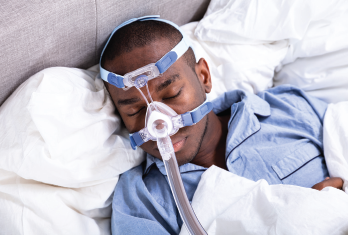What are the associations between Black race and positive airway pressure (PAP) therapy adherence among veterans with obstructive sleep apnea (OSA)?
BOTTOM LINE
Explore This Issue
January 2022Among veterans with OSA, Black race was associated with reduced PAP adherence, suggesting health inequality among Black individuals in the treatment of OSA.
BACKGROUND: Patient adherence to PAP therapy for individuals with OSA remains poor. Correlating factors to adherence include race, sex, marital status, age, and socioeconomic status. Studies examining the relationship between Black individuals with OSA and PAP adherence have been limited. Prevalence of OSA in certain cohorts of veterans is high.
COMMENT: Detecting racial health inequalities in PAP therapy represents an important first step in reducing health disparities among individuals with OSA. In fact, detecting is the first phase in a conceptual framework developed by Department of Veterans Affairs researchers. The remaining phases of disparities research include understanding and reducing. This study is the largest to date that examines the relationship between Black race and PAP adherence in the treatment of OSA, while adjusting for socioeconomic status and utilizing objective cloud-based adherence data. The authors found that Black race is associated with reduced PAP adherence among veterans with OSA and recommend that further studies seek to understand potential sources of this disparity at the level of patients, providers, clinical encounter, and the healthcare system.
—Boyd Gillespie, MD
STUDY DESIGN: Retrospective cohort study.
SETTING: University of California, Los Angeles.

© Andrey_Popov / shutterstock.com
SYNOPSIS: For their large-scale, retrospective study, researchers identified 2,571 patients who were newly diagnosed with OSA at a single Department of Veterans Affairs sleep center between January 2015 and November 2017, and who were newly started on PAP therapy with modem-enabled devices. Researchers used device-transmitted, cloud-based data, along with other demographic and clinical information, to examine the relationship between race and adherence, controlling for sex, marital status, age, socioeconomic status, residual apnea-hypopnea index, and mask leak. Adherence was defined as >4 hours nightly usage for at least 70% of nights from PAP setup. At 30 days, overall adherence was 50%. Black veterans (25%) had reduced 30-day PAP adherence (42% versus 53%) and nightly usage (216 minutes versus 251 minutes). There was no significant difference in adherence with respect to other racial subgroups. Authors note that, as veterans, this cohort had little to no out-of-pocket costs for treatment. Thus, after adjusting for the potential confounder of neighborhood socioeconomic disadvantage, Black race was still associated with a 36% reduction in PAP adherence. Study limitations included the retrospective design, which did not allow researchers to determine the basis for the relationship between Black race and lower adherence.
CITATION: Hsu N, Zeidler MR, Ryden AM, et al. Racial disparities in positive airway pressure therapy adherence among veterans with obstructive sleep apnea. J Clin Sleep Med. 2020;16:1249-1254.